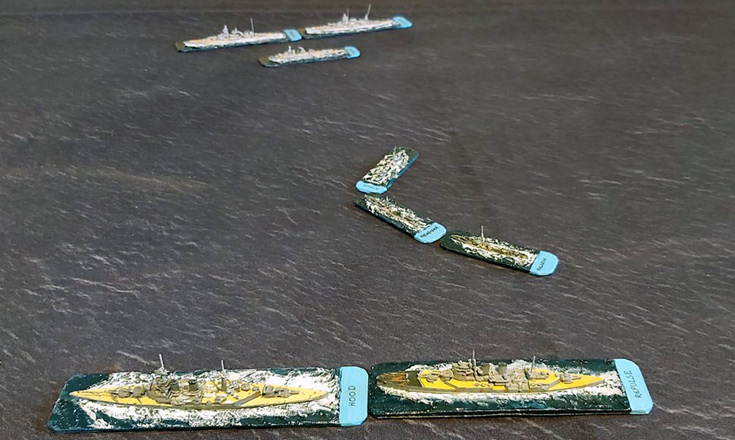
The Battle of Frøya 1940
21st August 2025, 7 Comments
World War 2 Naval, Nimitz, 1/2400-scale
I seem to start every game report with an apology! This one is exactly two months later. Sorry. I promise to do better. The thing is, my latest book Lords of the Salt Road has soaked up a lot of my time and attention, so I’ve been remiss in posting in a timely way. Still, better later than never, although better never late. This game came about because Sean bought a new set of rules. So, we agreed to give them a go. 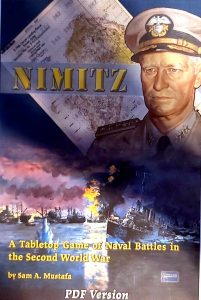 As it says on the cover, Nimitz by Sam Mustafa is a set of World War 2 naval rules. Now, I’ve always been pretty loyal to General Quarters (v3), but I was happy to give these a go. I’d heard a lot of good things about him, and I knew that my wargaming friends in Edinburgh have switched over to them. They’re less detailed than GQ, but when you want to get a game knocked out on a club night then that’s no bad thing, as long as they’re also quicker to play.
As it says on the cover, Nimitz by Sam Mustafa is a set of World War 2 naval rules. Now, I’ve always been pretty loyal to General Quarters (v3), but I was happy to give these a go. I’d heard a lot of good things about him, and I knew that my wargaming friends in Edinburgh have switched over to them. They’re less detailed than GQ, but when you want to get a game knocked out on a club night then that’s no bad thing, as long as they’re also quicker to play.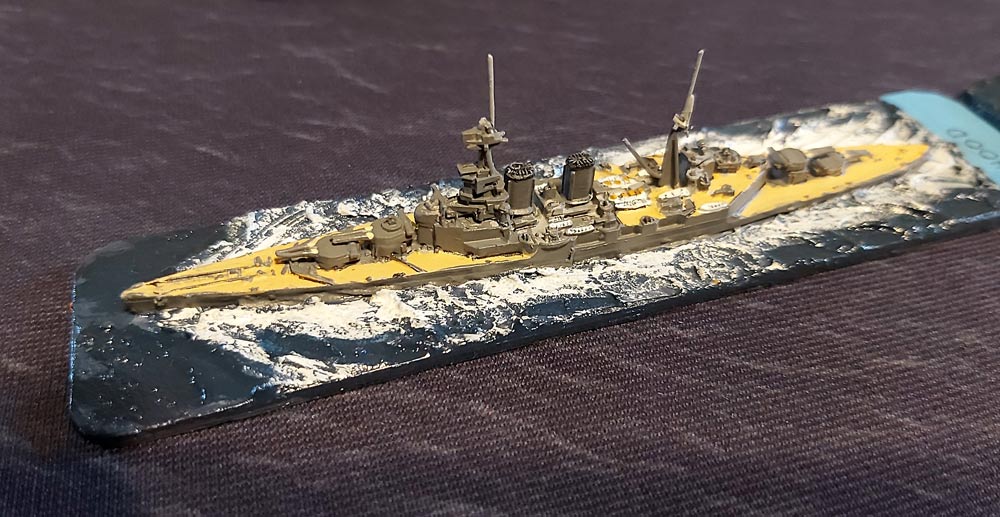 The Nimitz rules are accompanied by a useful website, which includes an introductory scenario, Operation Freya, which is set in the Norwegian campaign of April 1940. It’s an encounter battle, where the GErman battleships Scharnhorst and Gneisenau encounter the British battlecruisers Hood and Repulse, somewhere off the Norwegian coast. The Germans are accompanied by the light cruiser Nürnberg and the British by three O/P-class destroyers.
The Nimitz rules are accompanied by a useful website, which includes an introductory scenario, Operation Freya, which is set in the Norwegian campaign of April 1940. It’s an encounter battle, where the GErman battleships Scharnhorst and Gneisenau encounter the British battlecruisers Hood and Repulse, somewhere off the Norwegian coast. The Germans are accompanied by the light cruiser Nürnberg and the British by three O/P-class destroyers. 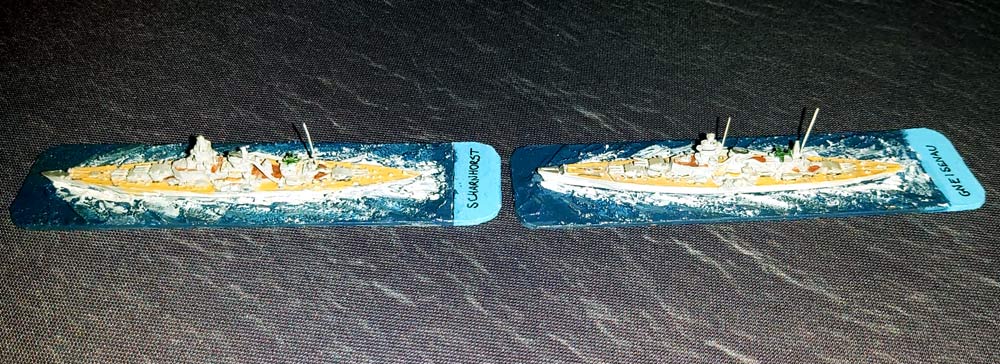 For the record, we set this off the island of Frøya, which is at the mouth of the Trondheimjford. It seemed as likely a place as any for the battle. In our game, the Germans (commanded by Nick) appeared on the northern long table edge, while the British appeared on the southern one. Sean commanded the two battlecruisers, while I ran the destroyers – Paladin, Pathfinder and Panther.
For the record, we set this off the island of Frøya, which is at the mouth of the Trondheimjford. It seemed as likely a place as any for the battle. In our game, the Germans (commanded by Nick) appeared on the northern long table edge, while the British appeared on the southern one. Sean commanded the two battlecruisers, while I ran the destroyers – Paladin, Pathfinder and Panther. 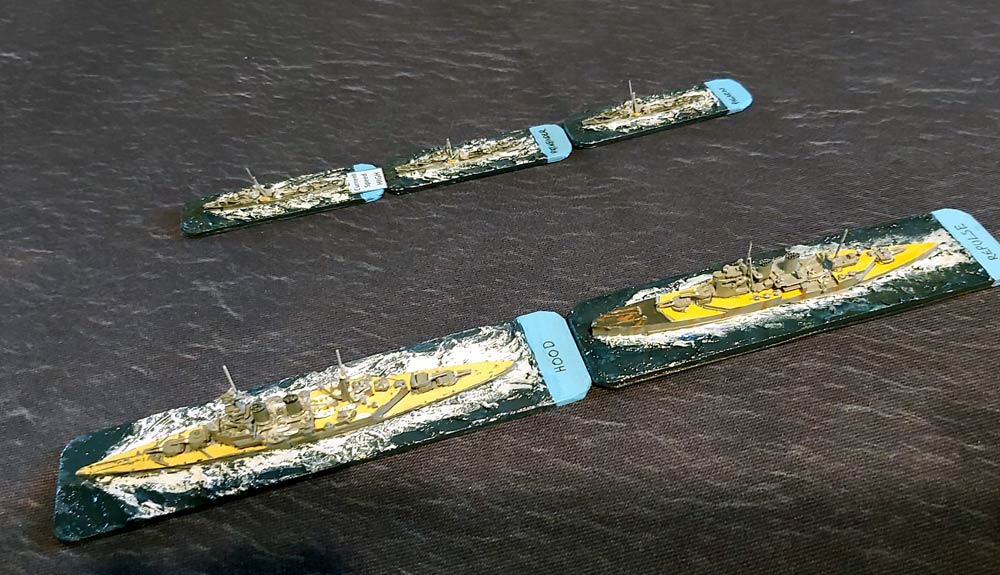 I actually didn’t have these three – or Repulse or Nürnberg, but as I planned to repaint my nametags grey rather than light blue, I didn’t mind renaming the model bases for the occasion. One of the quirks of Nimitz is that gun ranges seem crazily short – long range for guns of 8″ or more is just 24″ (60cm). As a result, the game scale looked out of odds with the size of my 1/2400 scale ships. So, that was something of a mental hurdle. Still, on we went.
I actually didn’t have these three – or Repulse or Nürnberg, but as I planned to repaint my nametags grey rather than light blue, I didn’t mind renaming the model bases for the occasion. One of the quirks of Nimitz is that gun ranges seem crazily short – long range for guns of 8″ or more is just 24″ (60cm). As a result, the game scale looked out of odds with the size of my 1/2400 scale ships. So, that was something of a mental hurdle. Still, on we went. 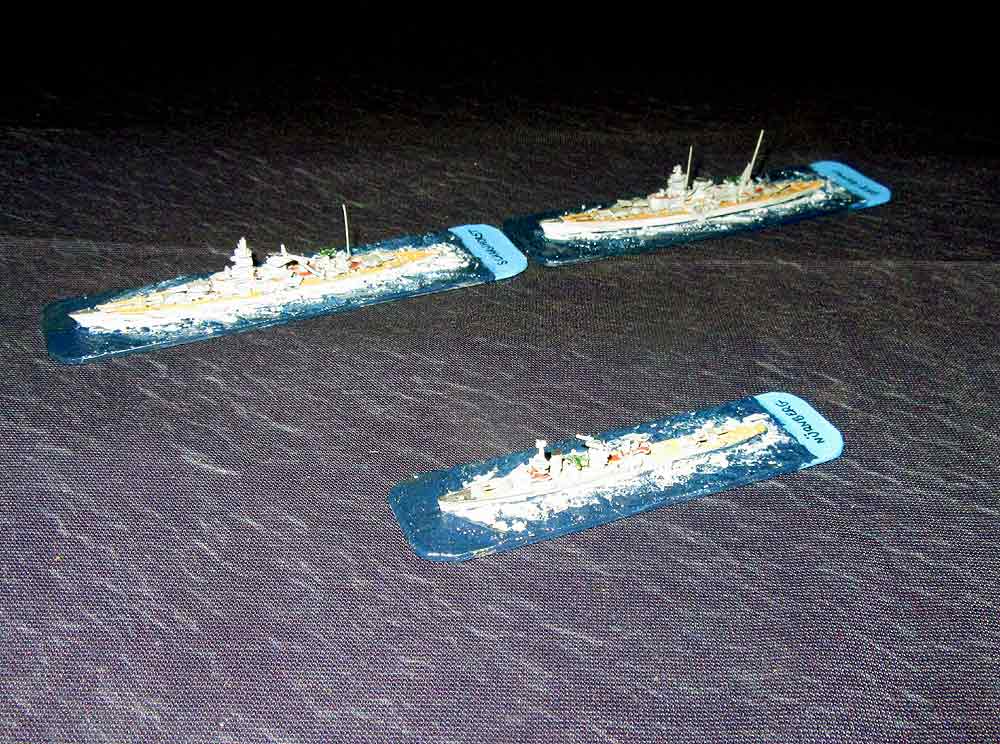 The two sides opened up with their capital ships were still within long range. they were on slightly converging course though, with Hood leading Repulse and Scharnhorst leading Gneisenau. Meanwhile, my destroyers closed the range, and Nürnberg turned to meet them. So, it was clear there would be two confrontations – a long range duel between the big ships, and a clash between the cruiser and the three destroyers.
The two sides opened up with their capital ships were still within long range. they were on slightly converging course though, with Hood leading Repulse and Scharnhorst leading Gneisenau. Meanwhile, my destroyers closed the range, and Nürnberg turned to meet them. So, it was clear there would be two confrontations – a long range duel between the big ships, and a clash between the cruiser and the three destroyers.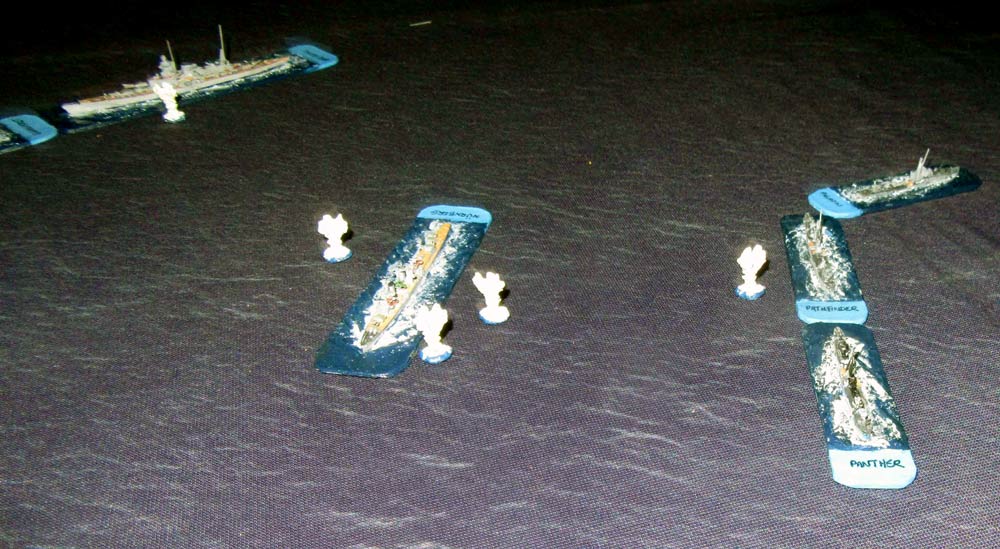 Gunnery was very straightforward. Each ship comes with a ship card showing the layout of the turrets on the left – with Repulse it’s two twin turrets forward and one more aft. The yellow triangles show arcs of fire. To shoot at long range (13-24″) you roll a dice based on the number of barrels firing and a few other factors, and check the table on the bottom right. In this, a score of 3-4 at long range means you’ve hit, and can penetrate an armour level of ‘6’.
Gunnery was very straightforward. Each ship comes with a ship card showing the layout of the turrets on the left – with Repulse it’s two twin turrets forward and one more aft. The yellow triangles show arcs of fire. To shoot at long range (13-24″) you roll a dice based on the number of barrels firing and a few other factors, and check the table on the bottom right. In this, a score of 3-4 at long range means you’ve hit, and can penetrate an armour level of ‘6’. 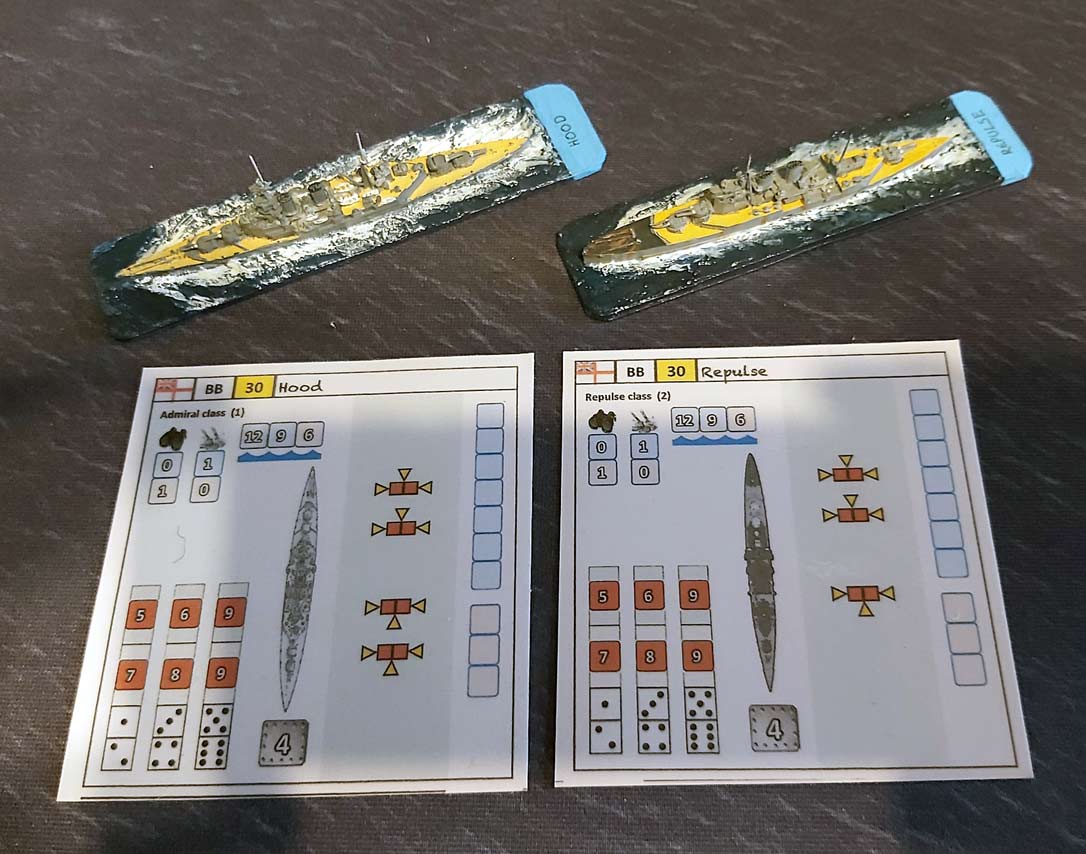 As the German battleships have an armour value of ‘6’, that’s not enough to penetrate, but you might cause some superficial damage. To get a penetration of ‘9’, the British 15-inch gun battlecruisers have to roll a 5-6, or move into close range, when all hits penetrate a ‘6’ armour. Then you roll to see what damage you inflict. Essentially, torpedoes work the same way. it’s all very simple and straightforward, and gets resolved very quickly .
As the German battleships have an armour value of ‘6’, that’s not enough to penetrate, but you might cause some superficial damage. To get a penetration of ‘9’, the British 15-inch gun battlecruisers have to roll a 5-6, or move into close range, when all hits penetrate a ‘6’ armour. Then you roll to see what damage you inflict. Essentially, torpedoes work the same way. it’s all very simple and straightforward, and gets resolved very quickly . 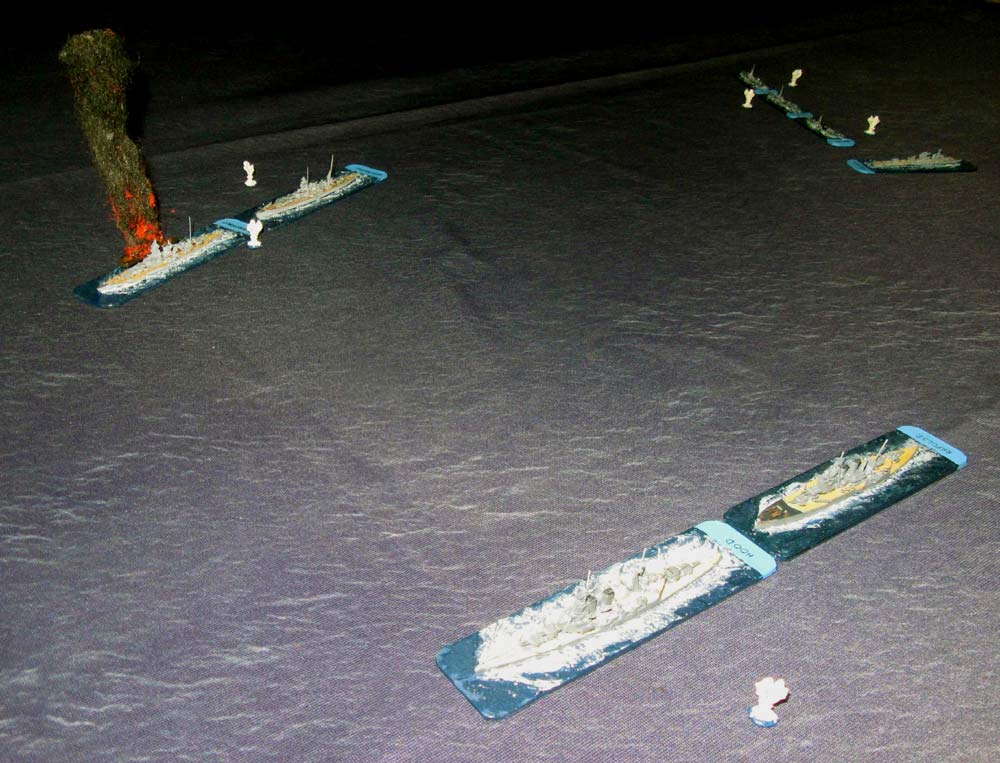 My destroyers flunked a torpedo attack on Gneisenau, as I messed up the angle, but Nürnberg pumped shells into Panther, my tail-end destroyer, and crippled her. However, Hood was hit by 11-inch salvos the German battleships, while a salvo from the old battlecruiser damaged Scharnhorst, and started a fire aboard her. The ranges were closing fast though, and with all that firepower on both sides, one good lucky hit could easily change everything.
My destroyers flunked a torpedo attack on Gneisenau, as I messed up the angle, but Nürnberg pumped shells into Panther, my tail-end destroyer, and crippled her. However, Hood was hit by 11-inch salvos the German battleships, while a salvo from the old battlecruiser damaged Scharnhorst, and started a fire aboard her. The ranges were closing fast though, and with all that firepower on both sides, one good lucky hit could easily change everything. 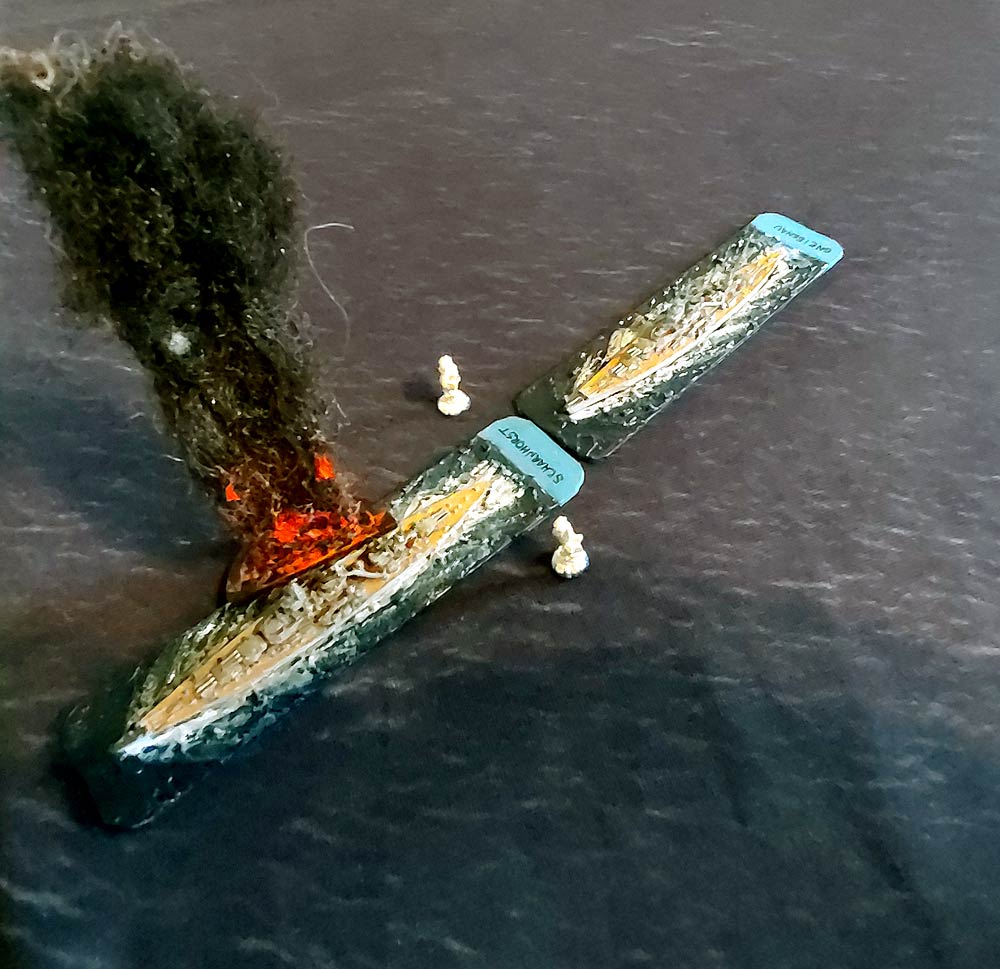 When it came it was rolled by Nick. A close-range salvo from Repulse struck Scharnhorst, and when damage was rolled for on two D6s, Nick scored a double six. That meant a magazine explosion, if the shell penetrated – which it did. So, Scharnhorst blew up, much to the surprise of everyone, as until then Nick’s die-rolling hadn’t been great. In return, Gneisenau caused some relatively light damage to Repulse, but not enough to make a real difference.
When it came it was rolled by Nick. A close-range salvo from Repulse struck Scharnhorst, and when damage was rolled for on two D6s, Nick scored a double six. That meant a magazine explosion, if the shell penetrated – which it did. So, Scharnhorst blew up, much to the surprise of everyone, as until then Nick’s die-rolling hadn’t been great. In return, Gneisenau caused some relatively light damage to Repulse, but not enough to make a real difference. 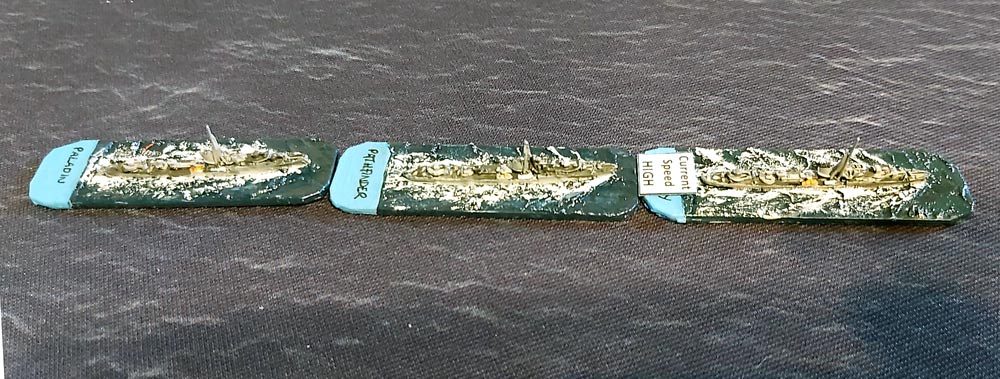 That single hit effectively decided the game, Bow the best Sean could do was to extricate his two remaining ships. My destroyers remained useless, having failed to torpedo Nürnberg. Worse, after taking more hits from the German cruiser, Paladin was crippled too. I was still chasing Gneisenau though, hoping for another change for a torpedo attack, but it wasn’t to be. The next turn Gneisenau steamed off the table, and so reached safety.
That single hit effectively decided the game, Bow the best Sean could do was to extricate his two remaining ships. My destroyers remained useless, having failed to torpedo Nürnberg. Worse, after taking more hits from the German cruiser, Paladin was crippled too. I was still chasing Gneisenau though, hoping for another change for a torpedo attack, but it wasn’t to be. The next turn Gneisenau steamed off the table, and so reached safety. 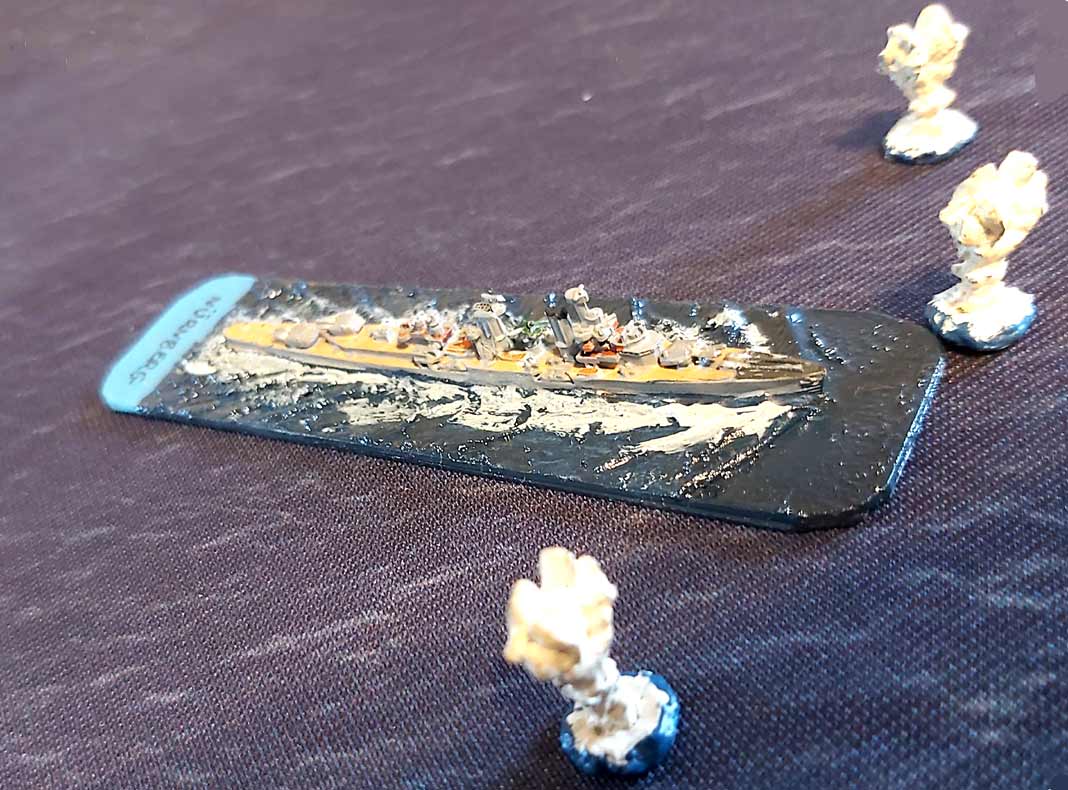 So too did Nürnberg, heading off the southern table edge. We treated this as both ships slipping away in the mist that was prevalent that cold April morning off western Norway. However, the game ended in a clear victory for the Royal Navy. Huzzah! As for the rules, Sean and I liked them, as they worked smoothly, and were quick to play. Nick though wasn’t so sure, as he preferred a little more complexity. We’ll certainly try them again though.
So too did Nürnberg, heading off the southern table edge. We treated this as both ships slipping away in the mist that was prevalent that cold April morning off western Norway. However, the game ended in a clear victory for the Royal Navy. Huzzah! As for the rules, Sean and I liked them, as they worked smoothly, and were quick to play. Nick though wasn’t so sure, as he preferred a little more complexity. We’ll certainly try them again though.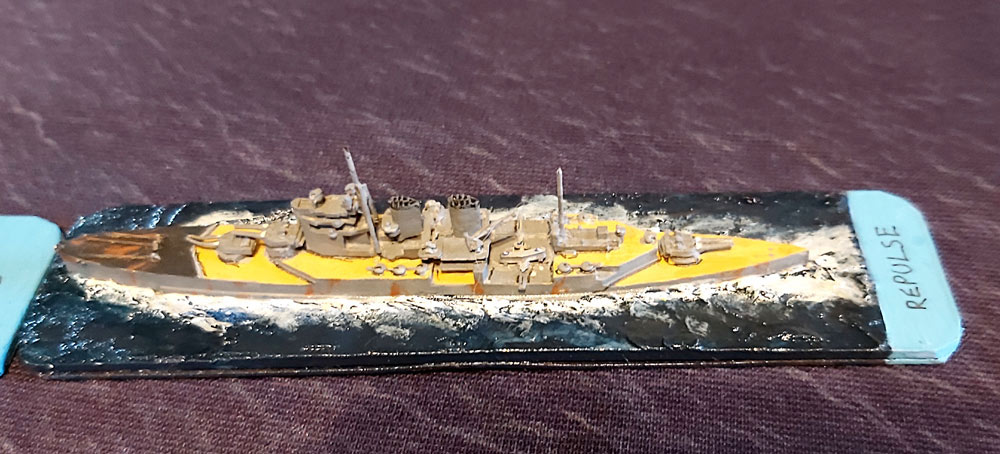
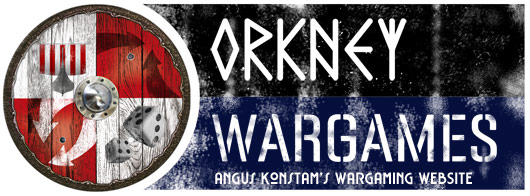
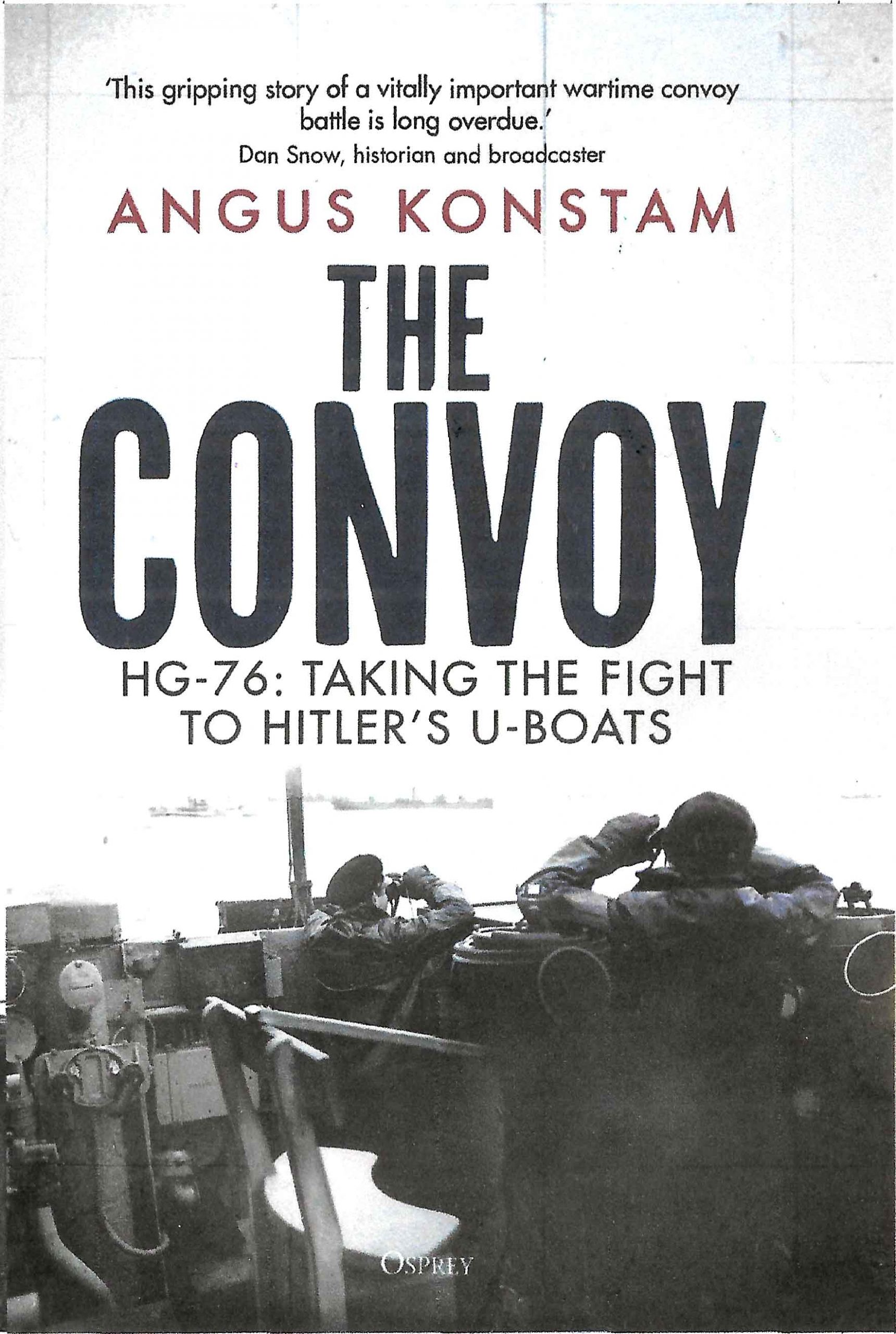

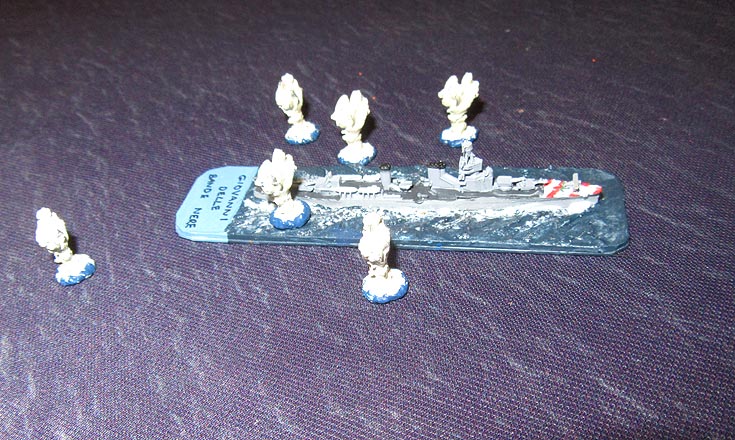
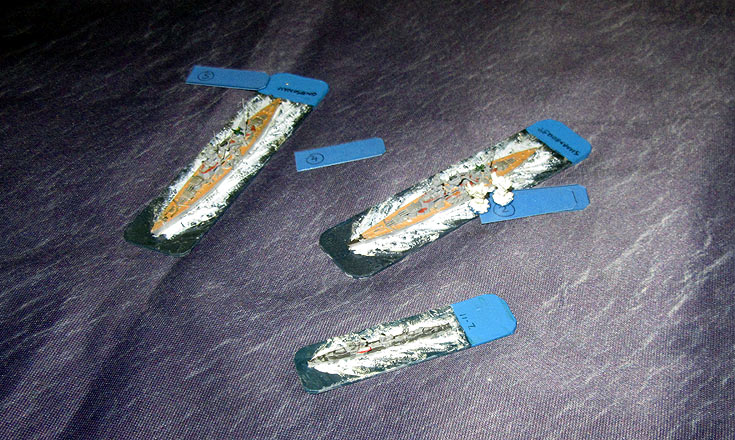
welcome back!
Yes – I’m afraid an overload of work got in the way of gaming and blogging!
Plus, my regular opponents kept going off on work trips or holiday…
We’re sort of on a more even keel now though, so once I’ve caught up the backlog, I’ll get things back on track.
Hurrah you are back!
Good to see it was work not health that accounted for your recent radio silence, Angus. I’ve played these rules also – once. Was early in the year and the Battle of the River Plate was our outing. I played the RN and was getting an absolute hammering when the Graf Spee decided to turn back and finish off my crippled survivors. Defeat from the jaws of victory and all that. Yes – magazine explosion! No doubt we’ll play Nimitz again some time in future.
Yes David – they’re fast and fun,and statistically the chances of a catastrophic magazine hit are no more likely than in General Quarters 3.
Nimitz has other foibles, most of which stem from the range and scale when you use 1/2400 ship models. I imagine it looks much more convincing in 1/6000 scale!
On the whole though, I rather like them, especially for a quick club night game. If I want a tad more detail, I’ll switch back to GQ3.
I was that Admiral who steered the Graf Spee magazines first into Exeter’s salvo. These things happen…
Our scale was 1/6000.
Table / model scale has always been a struggle with ww2 naval.
(Pesky boffins figuring out how to hit targets at increasing ranges).
Years back I concluded that 1/6000 was the only scale that would fit any table I could aspire to own.
Now I can cover most of the fleet ships from WW2.
Despite weakening eyesight I’ve no regrets.
Nimitz was the magic that unlocked the scale and table.
Steve, well, I’ll persevere, and we played another Nimitz game (which I’m about to post), where the scale problem was even more apparent with big 1/2400 scale models. Still, I really like the speed of the rules…